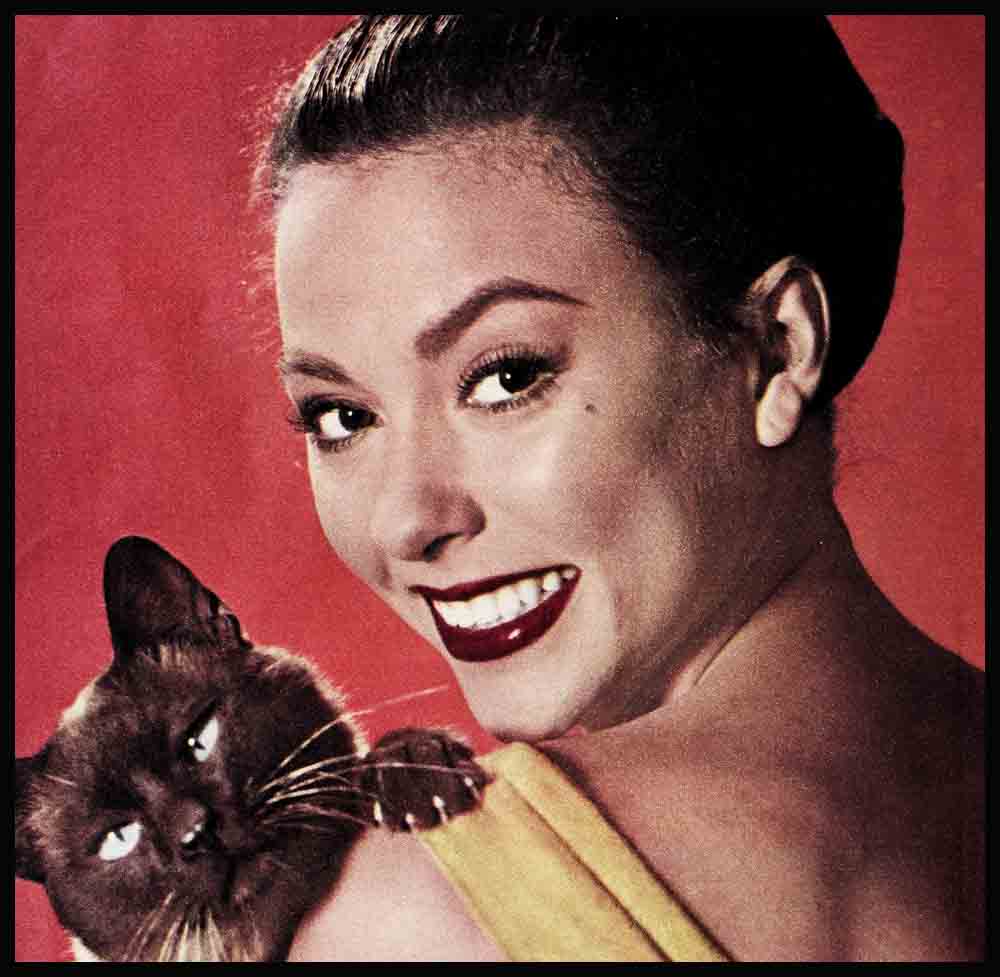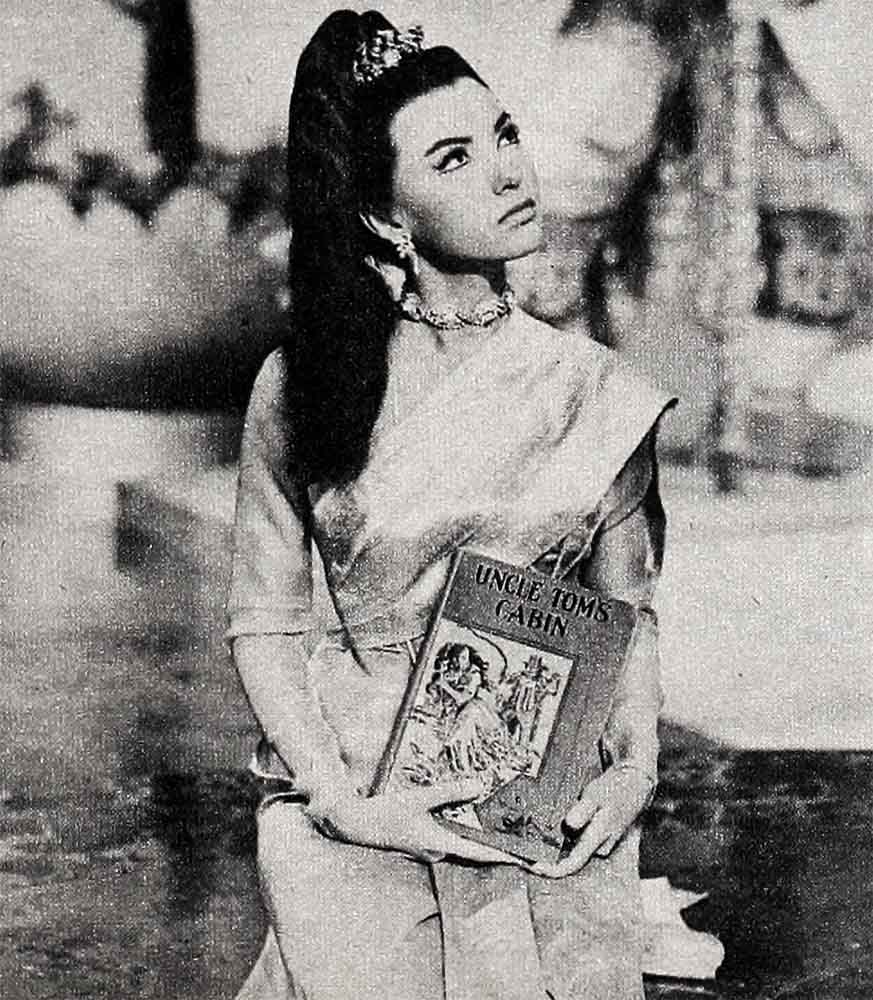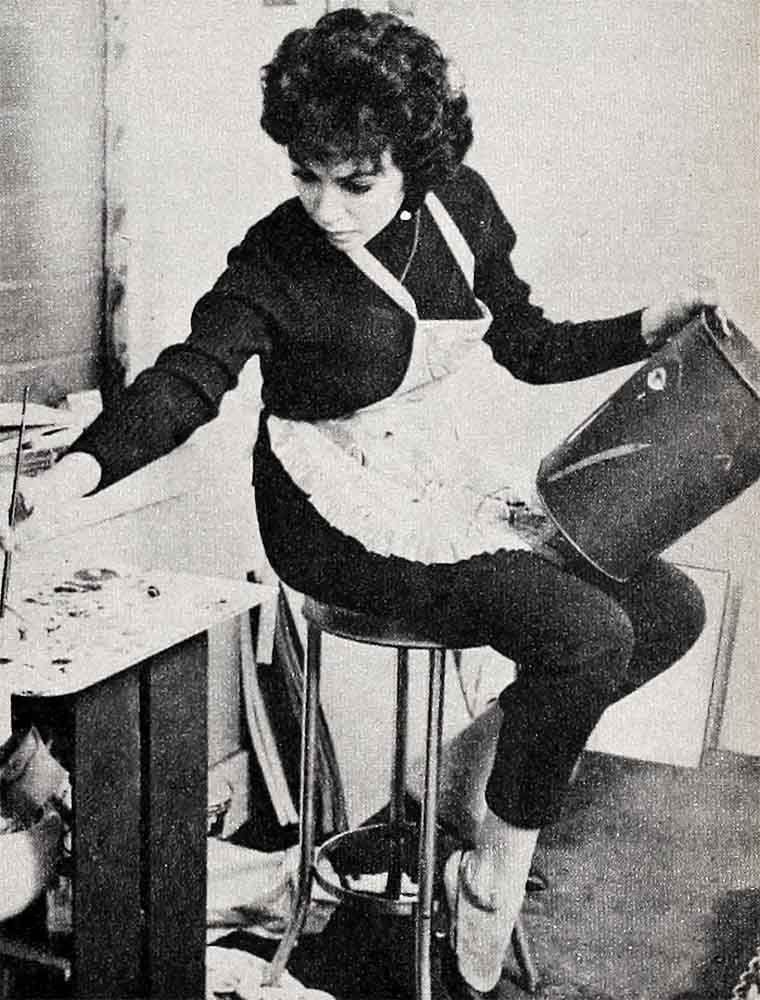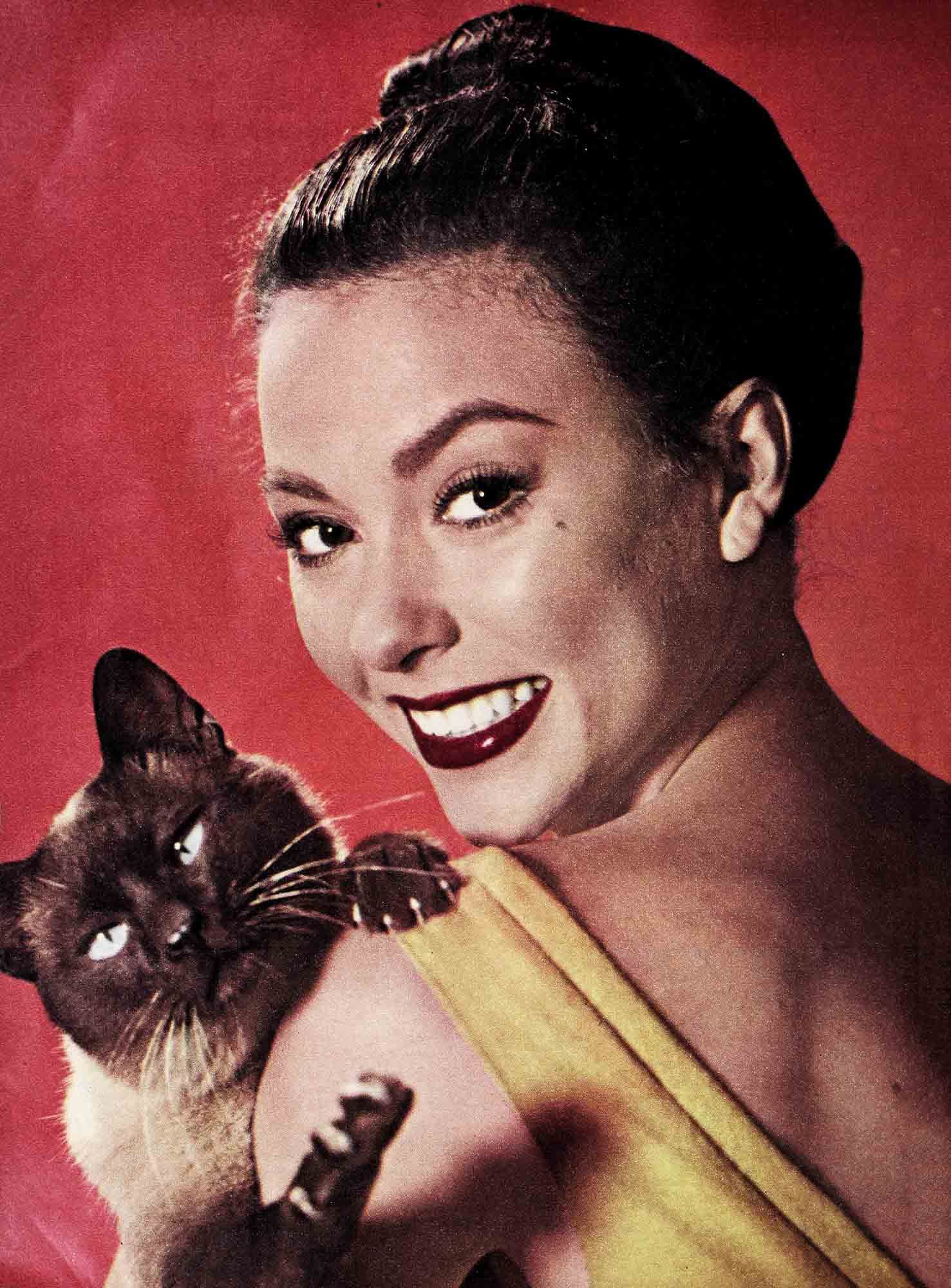
Hep-Cat Sage Hen
For once, Rita Moreno was glad that her car was a ’52 Ford, had a dent in one fender and needed washing. She parked it on a side street, got out and walked across the UCLA campus. Then, at the foot of the steps leading into the lecture building, she felt a sudden twinge of panic. What was she doing here? Rita Moreno, of all people, taking a course in Humanities? She wasn’t even sure what the word meant! All she knew, from the catalogue, was that the course was to guide her through some of the world’s great literature, from Moliére to Hemingway, and that this was something about which she’d lately developed tremendous curiosity. She was going to read Candide, War and Peace, and a lot of other books she’d always heard about but never had enough courage to tackle by herself.
“I don’t know what hit me,” she says now, her big brown eyes sparkling. “Heaven knows I’m not an intellectual. I always used to be at the bottom of my class, and at fifteen, in my freshman year, I quit high school. All I ever lived for in those days was dancing and a career in show business. But lately I’ve become very curious about a lot of the things I missed. I have no idea what brought this on, but I’m very glad it happened.”
A peppery little number who sparkles with animation, Rita likes a good time, loves to laugh, and would rather dance than eat. She never puts up a false front or any kind of pretense; she doesn’t go in for brooding, soul-searching, or trying to fathom the meaning of life. But recently she decided that she was in a rut and made up her mind to get something more out of life.
Besides going to school and liking it, Rita’s developed a taste for serious music, having a special fondness for the music of Richard Strauss. After being deathly afraid of stoves most of her life—for no reason she can remember—she’s learned to cook, and specializes in fancy dishes such as Chicken Tetrazzini and Sole Marguery, with all the trimmings. She’s also acquired a business manager and seriously intends to save money at last. And, after sharing an apartment with two girlfriends for seven years, Rita rented one of her own when one of the girls moved to New York. “It was time we split up,” she says. “We were getting too dependent on each other.”
Whatever caused this sudden burst of initiative, it is not the result of being in love. “I wish it were,” says Rita regretfully. “In all my life I’ve only been in love once. It happened a couple of years ago and it lasted for eight months, the longest I’ve ever gone with anybody. He sent me flowers and put romantic little notes in my mailbox. Maybe that’s corny, but I liked it. I want to be in love again. There’s so much I want to do but most of all I want to be a woman—a real woman.”

Rita won’t say with whom she was in love and, in case you’re wondering, it probably wasn’t Marlon Brando. However, Marlon is one subject Rita won’t discuss, except to express her enormous admiration for him. “Marlon doesn’t like it to have his friends talk about him,” she explains. “He considers it an invasion of his privacy, and I respect his feelings on that matter. All I can say is that he’s one of the gentlest and kindest persons I’ve ever known, and,” she adds emphatically, “all the other things that have been written about him are so much tommyrot.”
Whether or not Rita was, or still is, in love with Marlon, her “mental awakening” may well be a delayed reaction to being exposed to his stimulating mind and tremendous vitality. Nobody ever becomes friends with Marlon without undergoing some changes. For instance, he got Rita interested in the bongo drums, which she now plays like an expert. And there may have been other influences, which took a little longer to seep through and take hold. Rita says that she “wants to be a woman,” which is reminiscent of Marlon’s statement that his aim is “to be a human being.”
But, above all, Rita’s new slant on life is probably the result of her recent, long-overdue taste of solid success. For the recent changes in her coincide roughly with her work in “The King and I,” in which she portrays Tuptim, the beautiful lave girl who is involved in a tragic love story. According to reliable reports, Rita’s role in this film will lead her to stardom. “She can’t miss,” says Walter Lang, who directed “The King and I.”
Rita had wanted the part badly but, afraid to risk heartbreaking disappointment, she hadn’t allowed herself to hope for it. She knew she could handle the role and make the most of it. But she also knew that nobody at 20th Century-Fox, where she was under contract, was seriously considering her for it, even though she’d made test after test with a number of candidates for the second male lead, as an accommodation for her studio. For one test, in order to help a Spanish singer who didn’t know English, she had rehearsed all one Sunday, expecting nothing for herself in return.
Then one afternoon last September, the studio called her and said they wanted to see her right away. Rita had a date with her mother to take her to dinner and a movie. “I’m sorry I’m going to be late, Mommy,” she told Mrs. Moreno. “Wait for me. I’ll be there as soon as I can.”
When Rita finally arrived, she was very casual. “Well, Mommy, I got it,” she said.
“Got what?” Mrs. Moreno asked.
“The part of Tuptim. In ‘The King and I’ ”

Whereupon Mrs. Moreno almost fainted. “The way Rita announced the news you’d have thought she’d just bought herself a new pair of bedroom slippers,” she recalls. “She showed absolutely no emotion. I was the one who broke down.”
But for Rita, who normally has enough fire to light up a city block, her calm had a lot more significance than any amount of exuberance could have had. “I wasn’t teasing,” she says. “This meant so much to me I probably was too numb to feel anything.”
Getting that part was the final reward of more than twenty years of hard work and high hopes, a span of time covering most of Rita’s life. She’d been discouraged often, yet at no time had she ever let go of the dream that someday she’d be a big star in Hollywood.
“It’s all she ever wanted to be,” says Mrs. Moreno today. “Rita was a little ham when she was still in her baby carriage, vamping everybody in sight with her big brown eyes. And she had a way of worming herself into the hearts of a crowd before she knew much about dancing. She had it from the start, by whatever name you want to call ‘it.’ Rita was born to be in show business, and she could never be happy away from it.”
Rita started dancing almost as soon as she was able to toddle, performing for her mother’s Puerto Rican relatives and friends at the drop of a castanet. She showed so much natural talent that when she was only four her mother was persuaded to take her to Paco Cansino’s dancing school for an interview. Paco, who is an uncle of Rita Hayworth, was enchanted with the little girl and urged Mrs. Moreno to let Rita study dancing. Paying for dancing lessons was a big sacrifice for Rita’s parents, but Paco also showed his faith in her talent by letting Rita attend classes every day, instead of once a week for which he got paid, and by devoting a great deal of special attention to the youngster. “Maybe Paco’s interest wasn’t entirely unselfish,” laughs Rita. “When I was five and made my debut with him in a Spanish dance at a Greenwich Village club, I already was a perfect match for him in size. Paco is the shortest man I’ve ever known—but also one of the nicest and the most fiery. He helped me a lot.”

From the moment she started her lessons with Paco, dancing became Rita’s whole life. After working out at the dance studio all afternoon, she’d go home and dance some more, showing her mother the new steps she’d learned. Before long she was asked to dance at benefits and celebrations. This paid for her lessons, and it also helped toward the household expenses.
There were quite a few of these dates during the following years. Some were in Brooklyn, some in the Bronx, some in Queens, which added up to many hours in drafty subways, long waits for buses on windy street corners, and shivery walks through slush and snow. Rita didn’t mind; she was happiest when she could be before an audience. But it was hard on her mother, who always accompanied her.
When she was ten, Rita’s dancing school opened a Little Theatre in Macy’s Toy Department, and Rita performed with the children’s group. During the next three years, she chalked up a total of 770 performances. At the same time, she also worked in experimental TV, entertained at USO clubs, appeared on the radio, did commercials in Spanish, as well as dubbing-in films for export to Spanish speaking countries.
Although Rita was born in Puerto Rico, she and her mother moved to New York when Rita was an infant. Consequently, her Spanish was far from perfect. But this never worried her. One of her earliest auditions involved reading one of Margaret O’Brien’s parts in Spanish. It was a difficult, highly emotional scene, but Rita read it with such authority that the director decided it was easier to improve her accent than someone else’s acting ability. Subsequently, she was the Spanish voice of Elizabeth Taylor and Peggy Ann Garner.
At thirteen, Rita appeared in her first Broadway play, “Skydrift.” The play lasted only one week, after which Rita returned to dancing. When she was fifteen, she was engaged as a dancer at New York’s famous Leon & Eddie’s. This job also lasted only for a week, because Rita couldn’t persuade the authorities that she was twenty-one and entitled to a work permit. She then tried her luck at a smaller establishment in the Bronx. After a while, Rita decided to give up her studies at New York City’s Professional Children’s School and accept bookings out of town.
For the next couple of years, she danced in night clubs from Montclair, New Jersey to Montreal, Canada. Despite the frequent loneliness of her life and its occasional tawdriness, Rita rather enjoyed this phase. “I was kind of proud to be on my own,” she says. “I think almost any kid my age would have been. It was fun. And I learned a lot—about a lot of things.”

One subject Rita inevitably learned a lot about was men. Young, beautiful, unattached, a night-club entertainer, a girl who was unavoidably lonely, she was considered fair game by every roving male. It took someone with Rita’s sharp wits and common sense to retain her integrity and stay out of trouble. “There isn’t a line or an approach I haven’t heard,” she says. “I didn’t really mind, as long as I wasn’t fooled by it and could take care of myself. As a matter of fact, what I really resent now is the absence of a line. A lot of men just don’t seem to bother with it any more. They seem to think it’s enough to wave their Cadillacs at a girl. I’m no prude, certainly not—I never made any pretense of being one—but I do appreciate a certain amount of finesse.”
After Rita came back from her first series of out-of-town engagements, her mother persuaded her to take a secretarial course in typing and shorthand. “I was worried about Rita,” says Mrs. Moreno. “I knew she was a sensible girl, but I was worried about what this kind of life might do to her and where it might lead.”
Rita agreed to give it a try, but it lasted only a couple of weeks. When her agent called to say that he had another engagement for her, the temptation was too strong for her to resist, She packed up her books, closed the typewriter and went back to dancing.
Shortly before her eighteenth birthday—right in line with her ambition—Rita got her first part in a picture. Titled “So Young, So Bad,” the film was about re- form schools and was shot in New York. When it was finished, Rita went into rehearsals for a musical, “Signor Chicago,” with the late Guy Kibbee. Also at this time, she was contacted by an M-G-M talent scout who told her that Louis B. Mayer—then head of the studio—was in town and would like to interview her.
Rita arrived at Mr. Mayer’s hotel suite the next day, prepared to stay the usual twenty to thirty minutes. But he was so charmed by her that their talk stretched into the late afternoon. Rita finally had to take the unprecedented step of terminating the interview herself because she didn’t want to miss rehearsal. Mr. Mayer understood; he also had her signed to a stock contract the following day.
But in Hollywood, Rita’s career seemed to bog down. Hollywood is the kind of town where everybody either moves up—or down, and for a number of years, Rita wasn’t going up. In fact, it was quite a struggle to keep from hitting bottom. Although she went to work two days after she reported to the Culver City lot, and made four pictures during her first year there, her contract wasn’t renewed at option time. She was idle for nine long months before she got another job.
After several years and a series of un- distinguished pictures, Rita was signed to another contract, this time by 20th Century-Fox. From this point on, her career slowly started to gather momentum, but not until “The King and I”—more than six years after her optimistic arrival in the film capital—did it shift into high gear.
It’s no wonder then, that Rita feels as though she has emerged from the wilderness and has been blossoming out in all directions at once. For as her dream is coming within reach, Rita is becoming aware of all she’s missed while pursuing it. “I wasn’t happy as a child,” she says emphatically. “I didn’t mind going on the road at fifteen, but I don’t look back with any regrets on all the years before then.”
The cloud over Rita’s childhood wasn’t the result of any of the usual things, such as neglect, lack of affection or poverty. She had a stepfather, whom she called her “papu,” and she always got along very well with him. There wasn’t much money, but Rita never went cold or hungry,. and her mother, a skilled seamstress who still alters all of Rita’s clothes, took great pride in seeing her little girl nicely dressed. And she certainly gave Rita—an only child until well into her teens—as much love, care and companionship as any mother could. They’re still very close, and see each other several times a week.
But with it all, Rita was a shy and lonely child. She was sickly, caught endless colds, and was painfully thin. A solitary little figure, she was forever the outsider, always on the fringe of the other children’s fun.
Rita’s shyness was increased by the fact that she had talent. When other children were playing games, having fun, Rita was in dancing school working on her routines. It was what she wanted to do, but it kept her from developing friendships. And the fact that she was good and performed professionally only widened the gulf between her and other children. They approached her self-consciously.
Later, when she was invited to school or birthday parties, or later still to dances, some last-minute call for her professional services always seemed to interfere. “I remember one school dance I really wanted to attend,” Rita recalls. “A boy I had a crush on finally had asked me to go with him, and I was very excited about it. Mother had made me a beautiful dress for the occasion. But as the big night approached I was getting increasingly nervous about the whole thing. Then, on the afternoon before the dance, my agent called and said that he had an important date for me that night. By that time I’d become so jittery about my real date that I was glad I had an excuse to break it.”
Today, Rita has happily outgrown all traces of shyness and considers herself “very well adjusted.” She’s bright, cheerful, and vivacious, talks well and listens easily, is extremely popular, likes men and has lots of dates. Wherever she goes, someone in the crowd is bound to rise and embrace her affectionately. “Rita has hundreds of friends,” says one 20th Century- Fox executive. “Everybody likes her. And the nice part is that there isn’t anything phony about her friendliness. She’s a genuinely warm and outgoing girl.”
Though she has a hard time waking up in the morning, Rita usually starts to sing while she’s in the shower, keeps the hi-fi going most of the day, and usually winds up with a session on the bongo drums. “I had to get a ground-floor apartment,” she grins. “Nobody could stand living below me.”
Rita’s exuberance is extremely catching, but the one who’s caught it worst is her half-brother, Dennis, who is seven. He adores his sister, and Rita is wild about him. Someday she hopes to have lots of children of her own, but meanwhile Dennis is an excellent substitute. Rita loves to buy him presents, take him to amusement parks and treat him to giant banana splits. On Dennis’ insistence, she’s also been teaching him the Mexican Hat Dance, but she’s leery about giving him too much encouragement. “Dennis begs me to let him ‘do just one show business,’ ” Rita smiles, “but I tell him there’s plenty of time for that later on. There’s no need for him, too, to have to catch up on things in his twenties. I want him to have a normal, happy childhood.”
The nice part about Rita is that, even without “a normal, happy childhood,” she’s turned into such a radiant, healthy, well-adjusted young woman. But then, Rita’s exceptional. She’s quite a girl.
THE END
It is a quote. PHOTOPLAY MAGAZINE SEPTEMBER 1956




